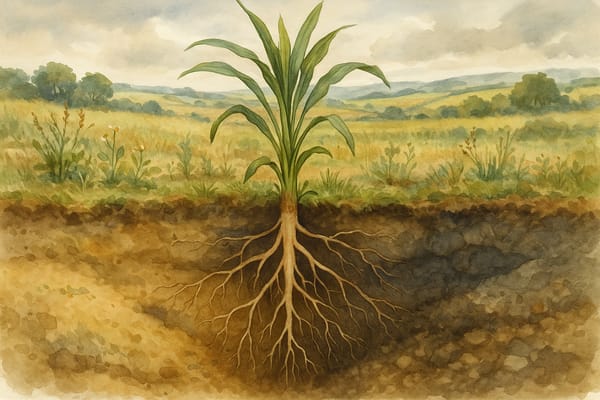In the dark beneath the soil surface, roots move through a world of quiet complexity—feeling, sensing, adapting. They twist through patches of clay, slip past stone, curl toward water, and brace themselves against compacted earth.
For centuries, we saw roots as simple absorbers, passively drawing water and nutrients. But new research from the University of Nottingham is upending that picture entirely. With pioneering tools that peer into the living fabric of root cells, scientists are uncovering a truth that could change how we grow food—especially in Cornwall, where soil is both a gift and a challenge.
The roots, it turns out, are listening.
A Cellular Symphony Beneath the Soil
In 2025, a team from the University of Nottingham, working with collaborators in the US and Belgium, revealed something extraordinary. Using single-cell transcriptomics and a new imaging method called phonon (or Brillouin) microscopy, they mapped how individual root cells respond to real, living soil conditions. Not sterile lab gels, but crumbly, compacted, nutrient-variable, microbe-rich soil—the kind you’ll find in Cornish pasture, moorland, or allotment.
What they found was staggering.
Root cells don’t just grow into soil blindly. Each one, from the outer epidermis to the inner transport core, senses and reacts to its local microenvironment—adjusting its gene expression to match what it finds. Where one patch might trigger a thirst for nutrients, another demands defence against pressure. Hormones signal. Walls thicken. Water channels shift. And crucially, it’s all happening one cell at a time.
This is no simple plumbing system. It’s a thinking, adapting, reactive organ—alive with decision-making.
Soil Compaction, Water Loss, and the Root’s Intelligent Armour
For Cornwall’s farmers and growers, soil compaction is a quiet adversary. Rain-saturated winters and the weight of livestock and machines press down on the earth. Air disappears. Water pools. Roots are left struggling for breath and space.
What Nottingham’s researchers discovered is that roots have a countermeasure: they stiffen.
Under stress, a hormone called abscisic acid (ABA) is produced in the inner root layers. It acts like an internal alarm, moving outward to trigger changes in the outer tissues. These cells begin laying down lignin and suberin—compounds that waterproof and reinforce. The result is a living barrier. Water loss slows. Damage is prevented. The plant protects itself.
This process was visualised for the first time using phonon microscopy, which allowed scientists to watch cell walls physically toughen in response to the pressure of soil. Roots, it turns out, don’t just survive—they brace.
Why Cornwall’s Soils Make This Research Vital
Cornwall is a county of contradictions. One field may be light and sandy, the next boggy and slow to drain. Some ridges dry out by midsummer, while the lower corners stay wet enough for rushes. Add in acid pH, centuries of grazing, and varied topography, and you have a soilscape that’s as complex as any in the UK.
That’s why this research matters here.
The heterogeneous soil microenvironments that Nottingham’s team explored are not theoretical in Cornwall—they are real, daily realities for farmers and gardeners. A single field may contain four or five distinct microzones, each posing different demands on plant roots.
With this new understanding, we can begin to imagine crops whose root systems are tuned to complexity—capable of sensing and responding to each patch of the field with just the right adjustment in water retention, nutrient uptake, or stress protection.
This isn't about engineering super-plants. It’s about helping plants do more of what they already do well—adapting with nuance.
From Research to Resilience: A New Path for Cornish Agriculture
For those managing land in Cornwall—whether a cattle farm, an organic veg patch, or a rewilded valley—these findings open new doors.
Crops could be bred or selected with enhanced root traits for resilience in compacted or acidic soils. Those with better ABA signalling might endure dry spells more easily or survive grazing pressure without stunting. And because this response is highly localized to specific cells, there’s hope that such enhancements could come without sacrificing yield in easier seasons.
The implications stretch further. Stronger root systems mean:
- Improved nutrient cycling, with fewer losses to leaching.
- Better carbon sequestration, as roots build stable, deep organic matter.
- Reduced erosion, especially on slopes prone to runoff.
- More effective use of cover crops, which rely on deep rooting to function fully.
And most importantly, these developments align naturally with Cornwall’s growing momentum toward regenerative and sustainable farming.
A Climate-Conscious Blueprint
Climate change is already reshaping Cornwall’s landscape. Wetter winters. Drier summers. Unpredictable storms. The very conditions that stress roots most are becoming more common.
But as this research shows, roots aren’t passive victims. They are sensors, architects, and first responders.
By understanding their language—the genes that switch on under pressure, the hormones that trigger defences—we can better support the plants that feed us, the fields that ground us, and the communities that depend on both.
The vision is not a high-tech future imposed on nature, but one revealed by it: a future where our crops are better listeners, our soils better respected, and our farming more deeply in tune with the ground it grows from.
The Road Ahead
This research, funded in part by the UKRI’s Future Food Systems and led by the L2025M initiative, is still in its early stages—but it represents a step-change in how we understand plant resilience.
And while its full agricultural applications may be a few seasons away, its message is already clear: plants know more than we thought. And if we listen to their roots, we might just grow a better future.








